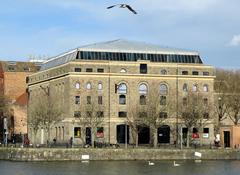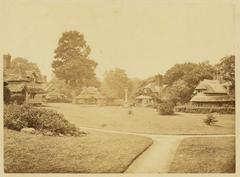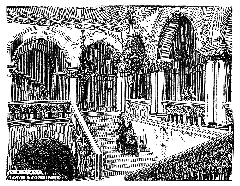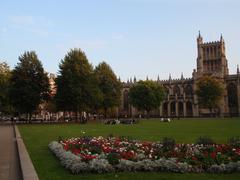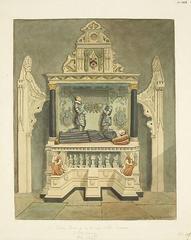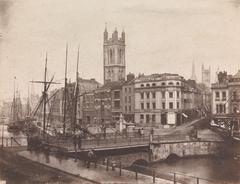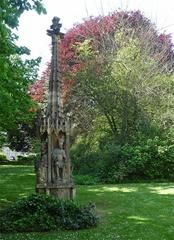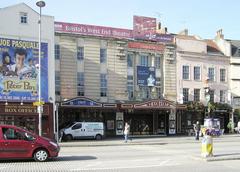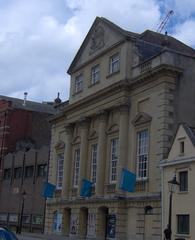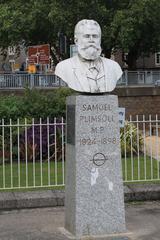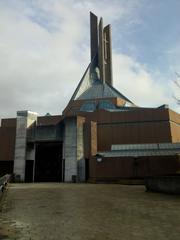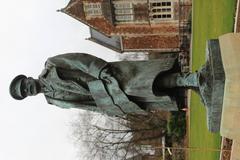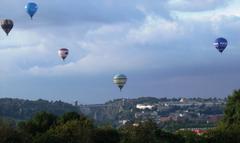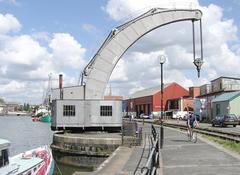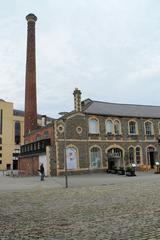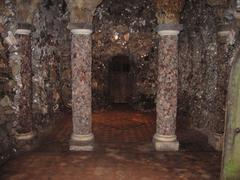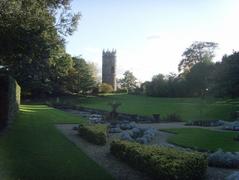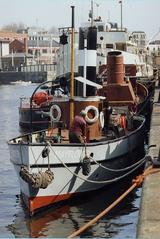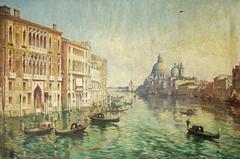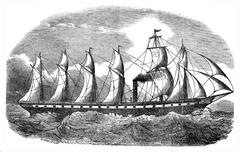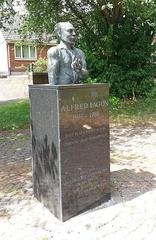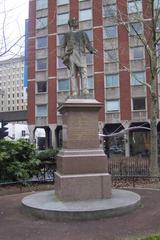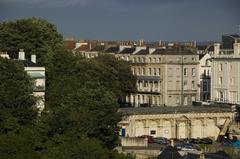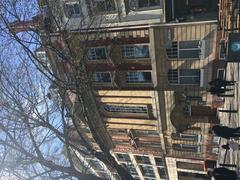
Underfall Yard Bristol: Visiting Hours, Tickets & Historical Site Guide
Date: 04/07/2025
Introduction: The Significance of Underfall Yard, Bristol
Underfall Yard, located at the western end of Bristol’s Floating Harbour, stands as a monument to the city’s centuries-old maritime innovation and industrial heritage. Founded in the early 19th century to address the challenges of the Bristol Channel’s extreme tides, the yard’s creation was pivotal in transforming Bristol into a major trading port. Today, Underfall Yard is both a preserved historical site and a living, working boatyard, offering visitors unique insights into the city’s engineering past and vibrant maritime culture (Visit Bristol; Wikipedia).
Table of Contents
- Origins and the Creation of the Floating Harbour
- Brunel’s Improvements and the Underfall System
- Victorian Expansion and Industrial Innovation
- 20th Century Changes and Wartime Impact
- Restoration and Heritage Status
- The Modern Era: Community, Education, and Resilience
- Architectural and Engineering Features
- Notable Vessels and Maritime Connections
- Visitor Guide: Hours, Tickets, Accessibility, Facilities
- Events, Tours, and Educational Programs
- Nearby Attractions
- Frequently Asked Questions (FAQ)
- Planning Your Visit
- References
Origins and the Creation of the Floating Harbour
Bristol’s commercial prosperity in the 18th and early 19th centuries was challenged by the River Avon’s dramatic tidal range—the second highest in the world. Ships frequently became stranded on mudflats, disrupting trade and threatening the city’s status as a leading port. In response, engineer William Jessop was commissioned to create the Floating Harbour, a revolutionary project completed in 1809 that maintained stable water levels and allowed ships to remain afloat regardless of the tides (Visit Bristol; Wikipedia).
As part of Jessop’s original design, the Overfall dam and sluices were constructed to manage surplus water and silt. However, the process of silt removal was laborious and required periodic draining of the harbour, disrupting operations (National Historic Ships).
Brunel’s Improvements and the Underfall System
By the 1830s, the limitations of Jessop’s system were evident. Isambard Kingdom Brunel, one of Britain’s most celebrated engineers, was tasked with enhancing the harbour’s efficiency. Brunel’s redesign introduced the underfall sluices, an innovative system that allowed silt to be removed more effectively without draining the harbour. This “underfall” system, still in operation today, gave the yard its name and made regular maintenance far less disruptive (Wikipedia; National Historic Ships).
The improvements enabled the development of a dedicated maintenance yard for the harbour’s infrastructure, laying the groundwork for Underfall Yard as a centre of maritime engineering.
Victorian Expansion and Industrial Innovation
The late 19th century saw significant expansion at Underfall Yard. Under the direction of engineer John Ward Girdlestone, the yard was rebuilt in the 1880s to consolidate dock maintenance operations. New workshops for shipwrights, engineers, and metalworkers were constructed, many of which survive today as rare examples of Victorian industrial architecture (National Historic Ships).
A notable addition was the Power House, completed in 1887. Originally powered by steam and later by electricity, the Power House supplied hydraulic power to cranes, bridges, and lock gates throughout the harbour. The Patent Heave-Up Slipway, based on a design patented in 1819, allowed vessels to be hauled out for repairs and remains a defining feature of the yard (National Historic Ships).
20th Century Changes and Wartime Impact
Through the 20th century, Underfall Yard remained the operational core of Bristol’s docks. It hosted maintenance for paddle steamers and other vessels, and its infrastructure was modernized with electric power and more efficient dredging systems. The yard suffered damage during World War II, including the destruction of key buildings, but continued to function as a vital maritime facility (Wikipedia).
Restoration and Heritage Status
By the late 20th century, parts of the yard had fallen into disrepair. Recognizing its significance, the Underfall Yard Trust led restoration efforts in the 1990s, reviving historic buildings and machinery. The slipway was among the first features restored, and many structures became Grade II listed. The site was also designated a scheduled monument, ensuring national protection for its unique heritage (Wikipedia; National Historic Ships).
The Modern Era: Community, Education, and Resilience
Today, Underfall Yard is both a working boatyard and a vibrant cultural attraction. The Visitor Centre, opened in 2016, offers interactive exhibits, live machinery demonstrations, and guided tours. The yard hosts educational programs, community events, and workshops that celebrate Bristol’s maritime legacy (Underfall Yard; MakeMyTrip).
A significant challenge arose in May 2023 when an arson attack caused extensive damage. The community responded with strong support, and restoration efforts continue to ensure the yard’s ongoing role as a hub of heritage and learning (Bristol Post).
Architectural and Engineering Features
Underfall Yard’s red-brick Victorian workshops, iconic chimney, and working slipway create a striking harbourside ensemble. The Power House, with its original pumps and accumulator, is a highlight for engineering enthusiasts. Many areas retain original forges, lathes, and belt-driven machinery—much of it still operational and demonstrated to visitors (Visit Bristol).
Notable Vessels and Maritime Connections
The yard has been closely associated with important vessels such as “The Matthew,” a replica of John Cabot’s caravel, and the “Mayflower,” the world’s oldest surviving tug, preserved by Bristol Museums (Bristol City Docks). These connections highlight Underfall Yard’s ongoing role in the city’s maritime story.
Visitor Guide: Hours, Tickets, Accessibility, Facilities
Opening Hours:
- Boatyard: Daily.
- Summer (Easter–October): 7:30 am–9:30 pm
- Winter (October–Easter): 9 am–5 pm
- Visitor Centre & Café:
- Monday–Friday: 9 am–4:30 pm
- Saturday & Sunday: 9 am–5 pm
- Open 7 days a week during special events (Underfall Yard Location & Hours)
Tickets & Admission:
- Entry to the yard, Visitor Centre, and café is free, with a suggested donation of £3 per person.
- Guided tours and workshops require advance booking and tickets, especially during peak periods (Book a Tour).
Accessibility:
- Wheelchair and buggy friendly for main paths, Visitor Centre, and café.
- Accessible toilets available.
- Assistance dogs welcome.
- Some historic areas may have uneven surfaces.
Getting There:
- Located on Cumberland Road, BS1 6XG, next to Cumberland Basin.
- No general visitor parking; limited disabled parking nearby.
- Easily accessible by foot, bicycle, ferry, or bus from Bristol city centre (Underfall Yard Directions).
Facilities:
- Café with indoor and outdoor seating, serving refreshments and homemade cakes.
- Visitor Centre with interactive exhibits and live demonstrations.
- Accessible toilets and baby changing.
- Gift shop and occasional pop-up markets.
Events, Tours, and Educational Programs
Underfall Yard offers regular guided tours of the workshops, slipway, and Power House, with live demonstrations of Victorian machinery. Special events include maritime festivals, markets, and family-friendly activities, especially during Bristol’s Harbour Festival and Gromit Unleashed (Underfall Yard Events). Educational programs for schools and community groups provide hands-on learning about engineering, tides, and boatbuilding.
Nearby Attractions
The yard’s harbourside location places it within easy reach of Bristol’s top attractions:
- SS Great Britain: Iconic steamship and museum.
- Spike Island: Contemporary art centre.
- M Shed: Museum of Bristol’s social and industrial history.
- Harbourside Walks: Scenic routes linking the city’s maritime landmarks.
Pubs and eateries such as Nova Scotia and Cottage Inn are nearby, offering traditional fare and harbour views.
Frequently Asked Questions (FAQ)
What are the visiting hours?
Boatyard: Daily, summer 7:30 am–9:30 pm, winter 9 am–5 pm. Visitor Centre: 9 am–4:30 pm weekdays, 9 am–5 pm weekends.
Is entry free?
Yes, with a suggested donation. Guided tours and workshops require tickets.
Is the site accessible?
Most public areas are accessible; some historic zones may have uneven surfaces.
Are dogs allowed?
Dogs on leads are welcome outdoors; not allowed in workshops.
Is parking available?
No general parking; use public transport or Park and Ride.
Can I book a guided tour?
Yes, booking in advance is recommended, especially for groups.
Planning Your Visit: Practical Tips
- Check the Underfall Yard website for the latest on visiting hours and events.
- Arrive early on weekends or event days for better access.
- Wear comfortable shoes for walking on historic surfaces.
- Support the Trust by donating or buying café refreshments.
- Follow safety guidelines as the yard is a working boatyard.
- Explore virtual resources and photo galleries online before your visit.
References
- Visit Bristol
- Wikipedia
- National Historic Ships
- Thornbury History
- Bristol Post
- Underfall Yard
- Underfall Yard Events
- Underfall Yard Location & Hours
- Book a Tour
- Educational Visits
- Private Hire Info



